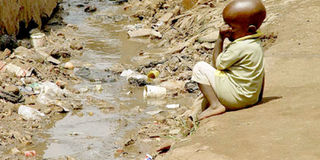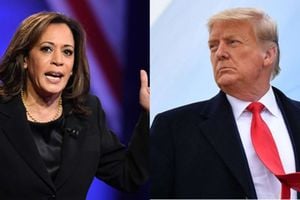Prime
Uganda after Museveni: What will it be like? Part I

A disillusioned child sits near an open trench that he has failed to cross in Kampala. FILE PHOTO
What you need to know:
Boredom sets in. At this stage in Uganda’s history and in the rule of President Museveni, with daily reports of yet more grabbing of land, looting of public money and impunity from top to bottom, reporting and commenting on these excesses of the government is starting to become rather boring to both the writer and the reader.
The public is getting weary of all these stories, not because they are not interested but because they send them deeper into gloom and despair and which excesses they are helpless to stop or prevent.
Better now to give or attempt to give readers a glimpse into the future, the place Uganda will be when Museveni is finally out of power. What will that Uganda be like? What will or might be the political calculations and decisions by those to succeed the NRM?
The answer to this depends on how Museveni leaves power. If he is succeeded by his son, Brig. Muhoozi Kainerugaba, in “Dear Leader” North Korea style, then Uganda will be made to walk in the father’s footsteps.
Only that Kainerugaba will take care to bring into prominent office more of the diversified classmates and friends he made at Kampala Parents’ School, Kings’ College Budo and St. Mary’s College Kisubi.
If Museveni’s successor is a popular leader like the FDC President Dr Kizza Besigye, he will have a lot of work to do. Uganda today is pervaded by an exceptionally bitter political and social climate.
The fate of westerners
When one mingles with ordinary people and compiles research on the national mood, one thing that stands out distinctly is the amount of bitterness that is felt in central Uganda against the westerners (the people colloquially called “Shae-shae” or Bashae-shae”).
Most of the biggest corruption scandals under the NRM have involved at least one prominent person from western Uganda. At present, all the heads of the armed services - the police, prisons, army and airforce - are from western Uganda, as are all the five Five-Star army generals.
What Baganda, Basoga and many in western Uganda used to feel about northerners from about 1966 to 1986, many of the same people now feel toward Banyankore and Banyarwanda. Or rather, more accurately, feel toward Banyarwanda and the sub-group within the Banyankore called the Bahima.
Baganda, whose very basis of existence lies with their clan system and their land, have seen huge tracts of that land bought up, seized and fenced off by senior political and military leaders and it is perceived - rightly or wrongly - that these grabbers of Buganda land are “Banyarwanda” and “Bahima”.
It is just that Buganda’s administrative seat at Mengo finds itself in a historical dilemma concerning how it lent all its support to the Museveni guerrilla war, only to find itself with a foe who has shortchanged it even more than the 1960s UPC government did.
Otherwise, it must have occurred to many, if not most, Baganda loyalists that in real terms the “desecration of my kingdom” that the late Kabaka Edward Mutesa II spoke of in his memoirs has taken place since 1986 and not 1966, now that the benefit of historical hindsight is at our disposal.
What happened in 1966 was an “attack on my kingdom”; what is taking place these days especially with land is what feels like the real desecration of the kingdom.
Besigye as head of state would have to, regardless of his personal wishes, lead much like the late President Milton Obote who came from Lango but drew some of his most loyal support from places as far apart as Mbale and Bushenyi.
Besigye comes from Rukungiri and given the bitterness against westerners that has been brought on by Museveni’s excesses, Besigye would have to make the effort for his government not to look like another outfit dominated by westerners.
Fortunately for westerners, so brutally and consistently so have Besigye, Ingrid Turinawe, Anne Mugisha, Winnie Byanyima, Maj. John Kazoora, and several other FDC leaders from western Uganda been treated by the police and the army, with front-page newspaper photographs and TV footage, that the brutality of the present time will be viewed by many Ugandans as that by Museveni and his regime and not by westerners.
But whatever happens after Museveni leaves power, the public anger will be such that only the absolutely and unquestionably deserving westerners will be appointed to top civil service jobs or awarded government tenders, contracts and university scholarships.
In the early years of the Museveni government, there were two main opinions about the guerrilla force that had brought him to power, the National Resistance Army (NRA). In the southern and western Bantu-speaking areas of Uganda, the general view was that the NRA had come as a liberation force, a sane voice and instrument for restoring order and discipline just when Uganda seemed about to fall apart.
In northern and northeastern Uganda in Sudanic, Nilotic Luo and Nilo-Hamitic areas, a very different view of the NRA took root from the very start. It was of a terror machine unleashed by Museveni and “his Banyarwanda” on the people of the north and northeast.
Reports, not just spreading as rumours but also reported by the BBC and various international human rights groups, spoke of a scorched earth policy in which granaries and grass thatched huts were set alight, women (and men) raped or sodomised and wells poisoned.
Unforgettable memories
It was this brutality, carefully hidden from the southern Bantu, that partly created the resistance fronted by Alice Lakwena, Francis (“Hitler”) Eregu and Joseph Kony.
Today, the two views of the NRA (now called the Uganda People’s Defence Force, UPDF) have merged into one and this one view is that which the people of northern and north-eastern Uganda first witnessed in 1986.
In Kampala and Masaka, especially since the arrest of Besigye in November 2005 days after his return from exile in South Africa, this image of a brutal, terror machine that is the Museveni army has been joined by the police.
From Besigye’s arrest to the Black Cobra (misnamed by the public as the “Black Mamba”) commando invasion of the High Court, to the violence used to quell the Buganda riots in September 2009 and the now uncountable instances of police use of teargas on crowds of demonstrators, the image has taken root of the police almost as being the army’s Fifth Division.
Since Lt. Gen. Kale Kayihura took over as the police’s Inspector General, the police have acted like the army, now in camouflage dresses like the army, been equipped like the army and (as photographs published by the Daily Monitor in November 2005 of the Black Mamba men demonstrated), even been the army dressed up in police uniform.
To many grassroots political activists, opposition leaders, human rights defenders and journalists in Kampala, since about 2001 under Brig. Henry Tumukunde, Col. Noble Mayombo, Col. Leo Kyanda and Brig. James Mugira, another deadly force, the one dreaded the most, has increasingly been the Directorate (later Chieftaincy of Military Intelligence, CMI), the army’s intelligence and security service.
The CMI has gained a reputation of being even darker than the main national intelligence services, the Internal Security Organisation (ISO) and its foreign intelligence-gathering counterpart, ESO. Many younger Ugandans born after 1976 probably fear the CMI more than older Ugandans feared Idi Amin’s State Research Bureau.
Stories of torture in safe houses, poisonings or rumoured poisonings of political opponents and arrests and vanishings have been widely reported by the local and international media.
It will be very difficult for the government that succeeds the NRM to retain these armed services and military groups in their current form, certainly under their current names. The only way these armed services will remain in place is if Museveni’s successor is from the NRM or is neutral about the NRM.
To be continued next week




